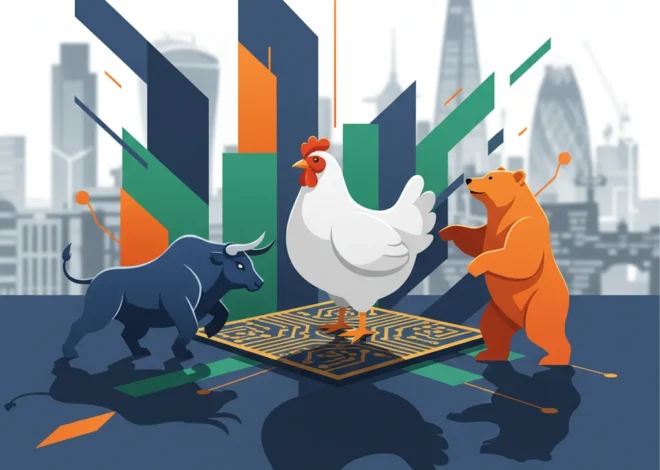
The Human Touch: Why Voice Trading is Making a Surprise Comeback in the $30 Trillion Treasury Market
In an era dominated by high-frequency trading, artificial intelligence, and the relentless march of financial technology, the image of a trader shouting orders into a phone feels like a relic from a bygone era. We’ve been told for decades that the future of finance is purely digital—a world of silent servers executing millions of trades in microseconds. Yet, a fascinating and counter-intuitive trend is emerging from the heart of the global economy: the $30 trillion U.S. Treasury market. The old-school method of “voice trading” is not just surviving; it’s thriving.
This isn’t a story of nostalgia or a rejection of progress. It’s a complex tale of sophisticated strategies, immense leverage, and the persistent need for human discretion in a market too large and too important to spook. The very fintech revolution that promised to automate everything has, paradoxically, created trading complexities that often require a human touch to navigate. Let’s explore why traders are once again picking up the phone and what it means for the future of finance, investing, and the global economy.
The Fintech Paradox: A Surge in Old-School Methods
For the better part of two decades, the narrative in financial markets has been one of disintermediation and automation. Electronic platforms replaced trading pits, algorithms replaced human market makers, and the cost of executing a trade plummeted. This fintech-driven evolution brought unprecedented efficiency and access to markets, from the retail stock market investor to the largest institutional players.
However, recent data reveals a surprising reversal of this trend in the professional rates-trading world. According to a report in the Financial Times, revenue from voice and “hybrid” (a mix of voice and electronic) trading at the world’s largest interdealer brokers has surged. These methods now account for 45% of their rates-trading revenue, a significant jump from just 38% in 2018. This isn’t a marginal shift; it’s a fundamental change in how the biggest players are conducting business in the world’s most important debt market.
To understand this phenomenon, we must look beyond the simple act of trading and delve into the intricate, high-stakes strategy that is fueling this comeback: the “basis trade.”
Deconstructing the Engine: The Hedge Fund “Basis Trade”
At the heart of this resurgence is a popular arbitrage strategy employed by some of the world’s most sophisticated hedge funds, including giants like Citadel and Millennium. Known as the “basis trade,” it’s a seemingly simple concept that is incredibly complex in its execution.
Here’s how it works in a nutshell:
- The Core Trade: A hedge fund buys a U.S. Treasury bond.
- The Hedge: Simultaneously, it sells a Treasury futures contract with a similar maturity.
- The Profit: The fund aims to profit from the small, often fleeting, price difference between the bond and its futures derivative. This difference is known as the “basis.”
While the profit on any single transaction is minuscule, the strategy becomes highly lucrative when executed at an enormous scale. To achieve this scale, hedge funds employ massive amounts of leverage, often borrowing more than 50 times their initial capital. This borrowing is typically done in the repurchase (repo) market, a critical but often opaque corner of the banking system where institutions lend to each other against high-quality collateral, like Treasury bonds.
This is where the need for human intervention arises. Executing a multi-billion dollar basis trade isn’t as simple as clicking a button. It involves three interconnected parts—buying the bond, selling the future, and securing the financing—all of which must be orchestrated perfectly to avoid disaster. The NHS on Life Support: A Financial Diagnosis and Prescription for Tech-Fueled Recovery
Why an Algorithm Can’t Always Compete
When trades reach this magnitude, the advantages of electronic trading can quickly become liabilities. The table below illustrates the key differences between electronic and voice-brokered trades in the context of a large, complex strategy like the basis trade.
| Feature | Electronic Trading | Voice/Hybrid Trading |
|---|---|---|
| Anonymity | Low. Large orders can be detected by algorithms, revealing a trader’s strategy (“information leakage”). | High. A broker can discreetly find counterparties without broadcasting the trade size or intent to the entire market. |
| Market Impact | High. A massive “buy” or “sell” order can instantly move the market price against the trader before the order is fully executed. | Low. Brokers can “work” the order, breaking it into smaller pieces and sourcing liquidity from various places to minimize price disruption. |
| Complexity Handling | Limited. Best for straightforward, single-leg trades. Coordinating a multi-leg trade (bond + future + repo) is challenging. | Excellent. A human broker can manage all components of a complex, contingent trade simultaneously, ensuring all legs are executed. |
| Liquidity Sourcing | Restricted to the available liquidity on a specific electronic platform. | Broader. Brokers have extensive personal networks and can call multiple institutions to find hidden pockets of liquidity. |
In essence, for these colossal trades, discretion is paramount. A voice broker acts as a shield, preventing the market from seeing the full size and scope of the fund’s intentions. They provide the nuance, negotiation, and network that an algorithm simply cannot replicate when billions of dollars are on the line.
However, there’s a darker side to this story. The basis trade, with its extreme leverage, introduces significant systemic risk into the economy. We saw this firsthand in March 2020 when pandemic-induced panic caused the basis to widen unexpectedly. Hedge funds faced massive margin calls and were forced to rapidly unwind their positions, leading to a fire sale of Treasury bonds. This selling pressure caused the Treasury market—supposedly the safest and most liquid in the world—to seize up, forcing the Federal Reserve to intervene with trillions of dollars to prevent a full-blown financial crisis. The fact that this trade is now larger than ever should be a major concern for regulators and investors alike. It’s a high-stakes game of financial Jenga, and the stability of the entire system could depend on not pulling the wrong block.
The Regulatory Shadow Looms
Regulators are not blind to the risks. Alarmed by the 2020 turmoil and the growing scale of the basis trade, the U.S. Securities and Exchange Commission (SEC) has proposed new rules aimed at shoring up the foundations of the Treasury market. The central proposal is to force a much larger portion of Treasury trades—especially those financed through the repo market—to be processed through centralized clearinghouses.
A central clearinghouse acts as a middleman for trades, becoming the buyer to every seller and the seller to every buyer. This has two key benefits:
- Reduces Counterparty Risk: If a hedge fund were to fail, the clearinghouse would step in to guarantee the trade, preventing a domino effect of failures across the financial system.
- Increases Transparency: It would give regulators a much clearer view of the leverage and risk building up in the system, allowing them to act before a crisis erupts.
While these rules could make the overall financial system safer, they could also make the basis trade less profitable by increasing the costs and margin requirements for hedge funds. This regulatory push represents the biggest threat to the voice trading renaissance. If the economics of the underlying strategy change, the demand for the specialized services of voice brokers could diminish once again. The AI Paradox: How Technology Can Restore the Human Touch to Recruitment and Drive Economic Growth
Conclusion: A Hybrid Future for Trading
The resurgence of voice trading in the Treasury market is far more than a simple throwback. It is a sophisticated adaptation to the realities of modern financial markets, where the scale and complexity of certain strategies have outpaced the capabilities of purely electronic systems. It highlights a critical truth: technology and humanity are not in a zero-sum competition. Instead, the future of trading is likely to be a hybrid one.
Algorithms will continue to dominate high-volume, standardized trading, offering unparalleled speed and efficiency. But for the largest, most complex, and most sensitive transactions, the human element—judgment, discretion, negotiation, and trust—will remain an invaluable, and highly compensated, commodity. The quiet comeback of the trader on the phone is a powerful signal that in the intricate world of global finance, the human touch is not obsolete; it’s essential. Benjamin Franklin's Ghost in the Modern Economy: Reviving the Case for a Land Value Tax This evolving dynamic between man and machine will continue to shape the landscape of banking, economics, and global markets for years to come.


